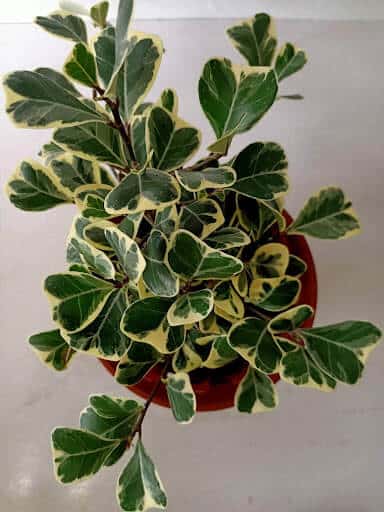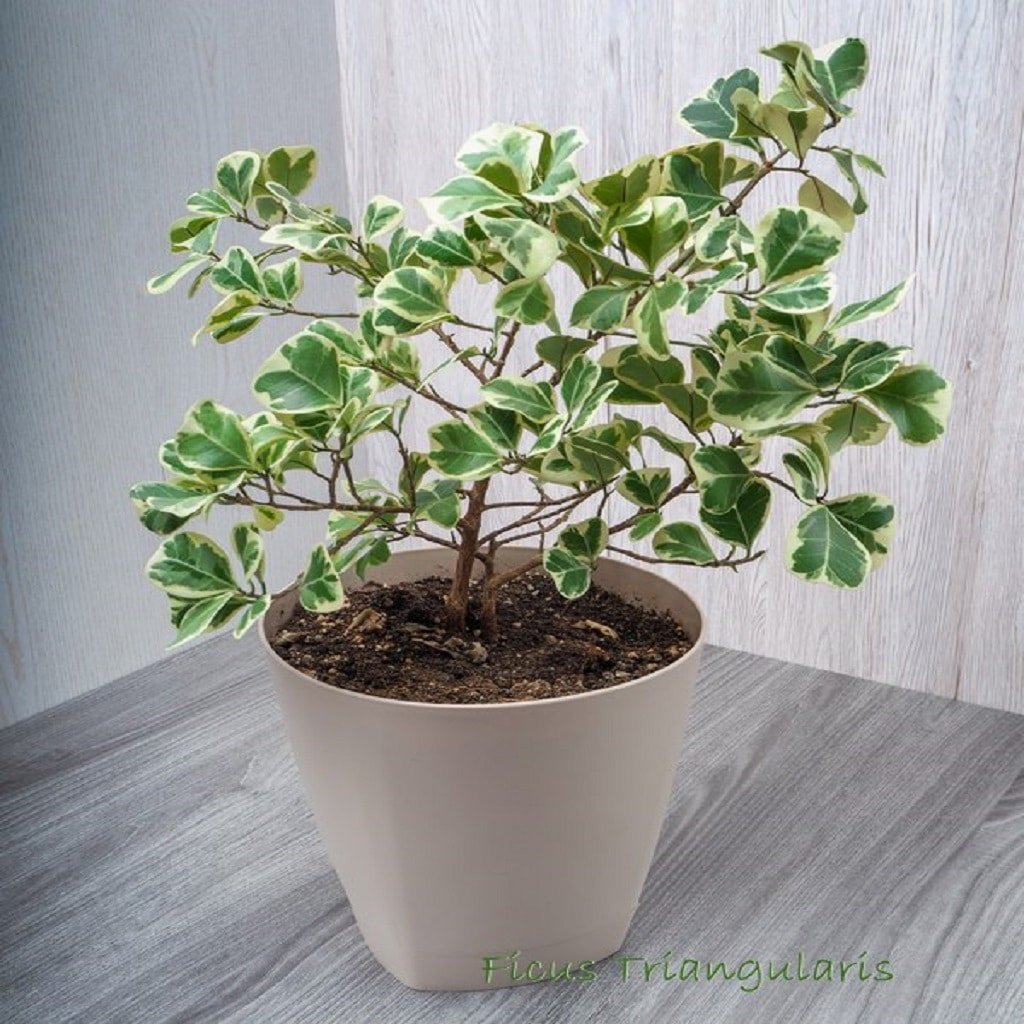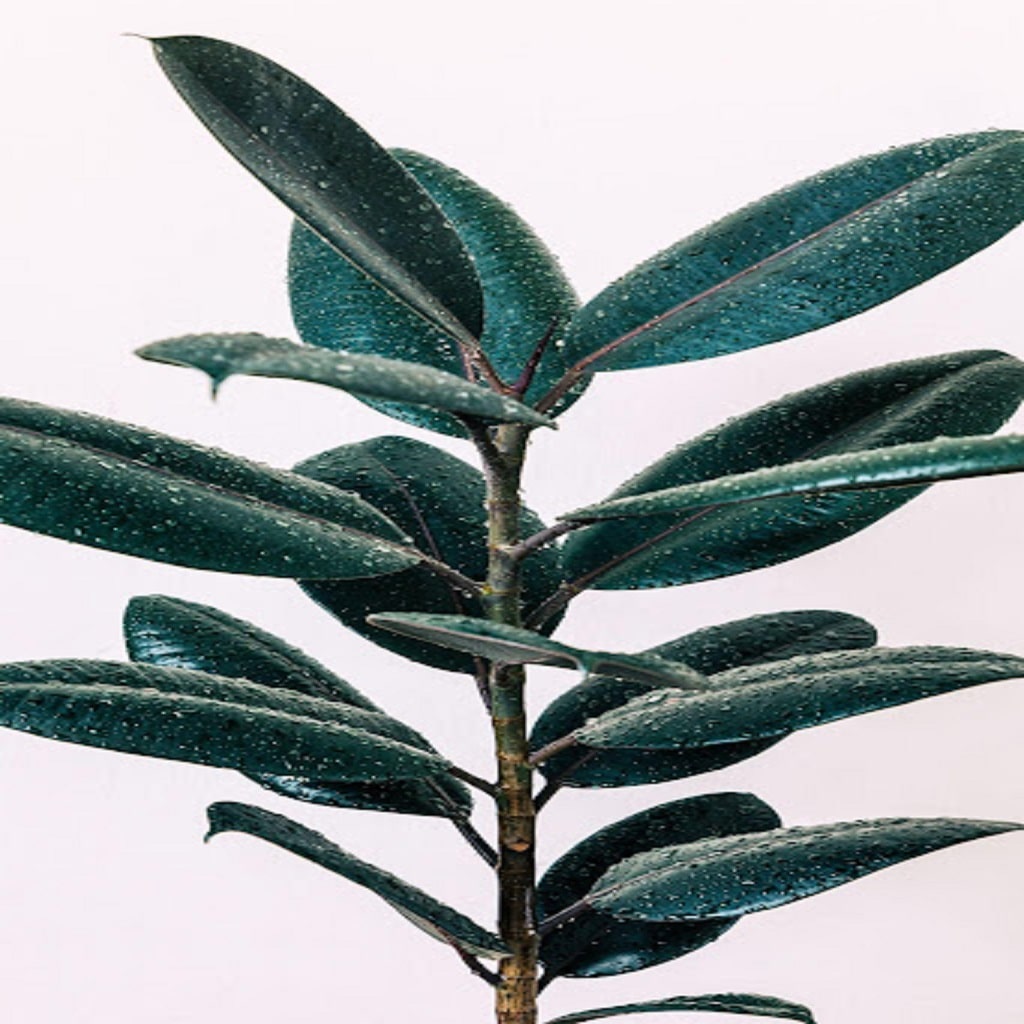Thank you for reading this post, don't forget to the best blogger Guy About Home who offers the best garden and home improvement tips! If you are a home decor and design fan, don't miss the tips on home ideas. If you are a home garden owner, then you might be interest in our complete guides to house plants!
Why is my Ficus Triangularis dropping leaves? Many gardeners look forward to growing this plant in their garden. However, many amateur gardeners get confused about the steps and measures required for its proper maintenance just as the loosing leaves issue. In this post we have gathered everything you need to know about growing and propagating a healthy and beautiful Ficus triangularis plant.
What is Ficus Triangularis?
The Ficus triangularis plant, also known as the Sweetheart Tree, is quite popular in South Africa and Asian countries. A healthy Ficus triangularis plant will have deep green and glossy leaves, with characteristic triangular-shaped leaves.
Ficus triangularis is a pretty common species of plant that can be found inside the households of many people.
Ficus triangularis is quite a durable plant that requires little or no maintenance and comes with its perks. Similar to hoya curtis, thus, this article is to enlighten our readers about how amazing this plant is and why it should be present in every household.
Ficus Triangularis Identification
It has green coloured leaves with a touch of light green at the central region and at the edges. However, this plant is durable and extremely easy to maintain.

Source: Google Images
Ficus triangularis benefits
Having a Ficus Triangularis in your dining room or living room can help you to filter out various harmful pollutants that accompany carpeting and furniture. Some of the contaminants include formaldehyde, benzene or trichloroethylene. Maintaining a Ficus Triangularis might be a tricky part, but once you perfect the watering and lighting requirements, they can last long.
Ficus triangularis VS. Other Ficus triangularis Plants
The Ficus family also have other varieties or similar types of plants. Many gardeners also prefer growing other beautiful plants like Hoya Pubicalyx and Longevity Spinach.
Ficus Triangularis Variegata
Many people who buy this plant refer to it as the Heart in the Snow. It is a very unique type of plant that you can have at your home. Finding this plant is a rarity.
Council tree or the Ficus Altissima
Ficus Altissima is a large plant. It possesses aerial roots and has a crown that is almost 100 feet wide. Ficus Altissima has characteristic ovate leaves. Its figs start growing in a yellow colour and turn red upon ripening.
Benjamin Fig
Benjamin Fig can be referred to as a shrub and is widely used as an ornamental or a shade tree. This plant has leathery and grows weeping red fruits. One exciting feature about this plant is that the wasps use the inside of the fruit as a mating zone.
Willow-leafed Fig
Willow-leafed Fig usually grows along kloofs and watercourses with rocky outcrops. It can grow up to 30 feet high. One characteristic feature of this plant is that its figs turn red and are hairless with short stalks.
Ficus Triangularis: Things to know
is ficus triangularis indoor or outdoor?
This plant is usually grown as an indoor plant. Once you have found a perfect location for your new foliage friend, avoid relocating it about your house as this plant, like its other ficus cousins, doesn’t prefer much movement. It is mainly found in South Africa and Asia and is also commonly known as the sweetheart tree.
Not confident in planting an indoor plant? Why not getting power from our inspiring indoor plants quotes?
Where to grow ficus Triangularis indoor?
Having a Ficus Triangularis in your dining room or living room can help you to filter out various harmful pollutants that accompany different carpeting and furniture.
Are Ficus triangular easy to grow?
Yes, It has characteristic dark green leaves that do not fall off easily. The genus of Ficus are given bad names because of one species, but the rest can grow surprisingly easily. Commonly known as the triangular focus, the Ficus triangularis is one of the most popular among them.
how big and tall does Ficus triangular get?
Commonly known as the triangular focus, the Ficus triangularis is one of the most popular plants among the Ficus family.
Ficus triangularis can have a place in your garden or inside your house. Like hoya chelsea, if it is planted in your home, keep in mind that the pot should at least have a length of 3 inches or more.
Because unlike its cousin Ficus Benjamina, Ficus Triangularis is a lot tougher than generally grows up to 8 feet in height over 4 feet wide.

Source: Google Images
Ficus Triangularis Care Conditions & Requirements
Here are some tips that will help you grow your plants well at your home.
Besides this plant, we also make a full care guide on how to care for Blue iris flower.
Ficus Triangularis Soil
The Sweetheart plant thrives in fertile soil. It is advised to keep the soil light, loose and abundant with minerals. Moreover, the roots of the Ficus Triangularis are permeable to oxygen. So it is recommended to use sphagnum peat moss or even pine bark in the ground. Also, you can separately buy a ready-made earthen mixture at a garden store, and to improve the drainage system, you might use some bricks or sand chips.
ficus triangularis soil mix
Another option is preparing a soil mixture yourself using appropriate portions of charcoal, leaf, sod land, and sand. You can use other ingredients and create a mixture using sod land, sand, peat, and leaves. Keep in mind that it is essential to maintain the ground acidity. The ground acidity must be higher than 6.0 to 6.5, and proper drainage should be available at the bottom.
Ficus Triangularis Temperature
You might leave your plant indoors during the spring and the summer season when the temperature generally ranges between 68° F -77° F. However, during the winter season, make sure that the temperature should not go below 60° F. Any sudden change in the temperature can damage the plant or affect its growth. During winter, try to leave your plant outside and expose it to a warm and fresh environment if it is present.
Don’t let the plant’s temperature drop. The temperature should be kept under check, especially during the winter and summer seasons.
Ficus Triangularis Humidity
Unlike manjula pothos, the Ficus Triangularis plant usually prefers a humid environment. You can try spraying the leaves with water. Spray your plant regularly during the scorching summer season or the freezing winter days. If you observe a lack of moisture, you can place a container filled with water next to it. You can also use wet clay in a pan.
Many people who buy Ficus Triangularis often invest in a humidifier which can be very beneficial for your plant’s health. Avoid placing your plant beside an AC or a vent.
Ficus Triangularis Light
The Ficus Triangularis prefers a shaded environment. It is advised to place your plant on your windowsill, which is facing north. Avoid exposing your plant to direct sunlight. It would help if you relocated it during the summer season as the leaves get overheated and burn. You might consider creating a bright but indirect light for your plant. However, if you have the Ficus Triangularis Variegata, it will require a good amount of sunlight to help its leaves droop or lose their colour.

Source: https://unsplash.com/photos/N7qkRnzVZok
Ficus Triangularis Water
To propagate your Ficus Triangularis, you should consider two factors – the season and the temperature. Ficus Triangularis needs adequate watering during the summer season. You should water it twice within seven to ten days. However, you might increase or decrease the frequency depending on the temperature, but make sure that the soil is adequately moisturised. Do this only when the compost is completely dry.
You can decrease your frequency by watering it once every seven to 10 days during the autumn and winter seasons. But, it is essential to ensure that the water does not stagnate in the soil, as the roots might get rotten. It is advised to use distilled water to water your plant at room temperature.
Water it until the top three inches feel dry. You can check the moisture by sticking your finger in the soil. You can also use moisture meters which are readily available at the garden centres.
Ficus Triangularis potting, repotting & pruning
Ficus Triangularis can be a little tricky to take care of compared to other species in the Ficus collection. Same as ficus altissima, this plant requires regular pruning.
The secret to making these plants thrive is to give them proper water soaking, equipped with an appropriate drainage system at the bottom.
Also, it would help if you let them normally dry out to about half of the pot size. Then you give it another full drink.
How to Propagate Ficus triangularis?
Same as polyscias fabian, trachyandra tortilis, propagating the Ficus Triangularis Sweetheart plant is not a very hard task. Many people use the apical cutting method to determine the appropriate cutting size.
This plant grows slowly, and you have to keep a few things in mind while propagating it :
- Make sure to remove cuts of at least 18 inches long with healthy leaves using sterile pruning shears.
- Place the cuttings in a suitable medium consisting of sand, perlite and peat.
- Place the cuttings in a room with a moderate temperature using filtered light, or cover them with polyethylene to increase humidity.
- You can remove it after the plant develops roots. After two weeks, you can transfer it to a larger container and grow it into a mature plant.
- During the first two weeks, your cuttings require bright, warm, and humid temperatures. By the third or fourth week, the roots will begin to stretch and now is the right time to separate the bags.
- By the fifth or seventh week, roots will start to develop, which is when the plant should be repotted.
- It takes all your patience to allow your Ficus Triangularis plant to grow and be consistent with your help for a good 2-4 months.
Besides this plant, we also make a full care guide on how to propagate Succulents.
Ficus Triangularis: Common Care Problems & Tips
No worries! Though you might encounter the difficulties when learning how to care such an plant as a new plant caring starter, we got the most popular plant lover quotes that can partner with you and you are going to succeed in plant care and grow.
Besides this plant, we also summarize the caring issues and concerns on the plant Hoya chelsea.
Ficus Triangularis dropping leaves
Ficus Triangularis losing its leaves is a very common problem faced by many people who buy this plant. This happens because your plant is not receiving the required amount of water. Some other reasons include a dry environment, receiving too little light or even a sudden change in temperature. If your plant is dropping leaves, it indicates that your plant is not receiving the required amount of water. Also, your soil should be equipped with a proper drainage system.
Ficus Triangularis leaves turning yellow
If your Ficus Triangularis leaves are turning yellow, then perhaps you are killing it with overwatering or underwatering. Also, your soil should be equipped with a proper drainage system.
What is the sap-like substance dripping from the plant?
In case you observe a sap-like substance dripping from your Ficus Triangularis, it isn’t sap. Just as dischidia ovata, it indicates that a pest has invaded your plant, and the sap-like substance is actually honeydew.
Ficus Triangularis Pests & diseases
Like most houseplants, you need to deal with various types of pests and diseases that might affect your plant.
Various insects like Mealybugs, thrips, aphids, scale, and spider mites can create a nuisance as they love to suck out the juices from the Ficus Triangularis.
To remove them, you can try to pluck them off using your hands. You might also use mild pressured water to remove them. Many people make their own pesticide by mixing two tablespoons of Neem oil with one tablespoon of mild dishwashing soap and water. Apply this mixture to your plant and keep the pest away.
How much does a Ficus Triangularis cost?
On average, a small Ficus Triangularis can cost around $10 to $12. However, the cost increases with the increase in height. A fully grown healthy Ficus Triangularis can be around $20.
Moreover, you have to use a good fertilizer that will help your plant to provide the required nutrients essential for its growth. You should fertilize the soil once every month in the spring season and the summer seasons. A decent fertilizer will cost you around $5 to $10 at your local store.
If you want to try the other types of plants, crispy wave fern, monkey face orchid, lemon button fern are also good options since they are easy to care for and not expensive.
Where to buy a Ficus Triangularis?
Ficus Triangularis is quite a rare plant. Your local gardening retail store might not have it. You can, however, find your Ficus Triangularis on the internet at various shops online.
All you need to do is input “Ficus Triangular” in the search bar of the search engines or the Facebook Marketplace. You will easily find your desired plant on these portals.
You can also find these plants online. You may find established plants or cuttings. Ficus Triangularis is another indoor plant that you can choose to keep.
You may also find these plants from other sellers present online. However, double-check the ratings and the reviews to ensure that you are buying from a reputed store.
For more amazing ideas you can have, visit Guy About Home today or you can check the related blogs:
- How To Install A Water Butt To Collect Rainwater
- Monstera Dubia: A Full Guide For Caring Monstera Dubia
- How To Create A Pollinator Garden
For more step-by-step ideas, diy tips and guides, kindly visit the website guyabouthome.com providing the best garden & home improvement tips.




